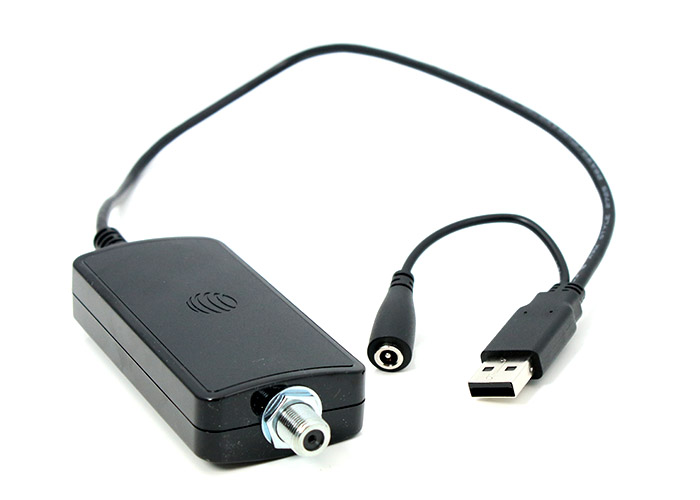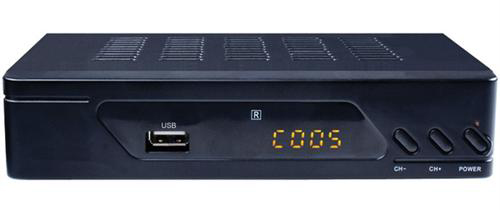DIRECTV’s H26K Commercial Receiver is a big topic of discussion here at Solid Signal. And it should be, since it’s the first new DIRECTV receiver since 2015 and the first one to support 4K in a standalone receiver. There are all sorts of questions about it that people tend to ask, and as they come up I try to get them answered.
Well, it’s this:

The Local Channel Connector was produced in very small numbers in 2018 and 2019. Its purpose is to integrate over-the-air antenna channels into the DIRECTV guide. DIRECTV had a device like this in the late 2000s, but it had long since gone out of manufacturing.
The LCC was never intended as a moneymaker or even as a mainstream product. It was built it small numbers and given to customers who complained about a channel blackout. AT&T, who owned DIRECTV at the time, considered it a minor expense. It was, at least compared to the cost of losing a customer because of a minor interruption.
The enthusiast community, the folks that Solid Signal serves, were very enthusiastic about the LCC. After all, DISH has a very similar product which integrates over-the-air channels into their Wally and Hopper units. And so, for about four years, we at Solid Signal have been in the uncomfortable position of having to tell people that we don’t sell the LCC. We don’t, because no one does. For those who have ended up getting one, they’ve tended to treat them with great care knowing that a replacement probably won’t be forthcoming.
The LCC is compatible with all older DIRECTV hardware up to and including the HR54 DVR. It’s not compatible with the Genie 2, and unfortunately it’s also not compatible with the new H26K. I don’t expect that to change.
At its heart, the Local Channel Connector is a fairly off-the-rack USB tuner with a custom driver to work with the version of Linux that DIRECTV uses as well as their specific hardware. The reason you’re not seeing support for the LCC in newer devices is that there’s no interest in developing those new drivers. The folks at DIRECTV seem to be saying that they don’t think enough people would be interested in getting an OTA solution for their newer hardware.
As for the LCC itself, as I said it was built in very small numbers and no new manufacturing run is planned. Remember, the original design is 6-7 years old at this point. They would more or less have to start the design from scratch. Since DIRECTV’s data suggests that there isn’t enough demand, that doesn’t seem likely.

If you have all your receivers in a rack, it’s very easy to add over-the-air programming to your matrix switched system. Choose an inexpensive box like this Proscan Converter Box which will tune your over-the-air channels. It has an unencrypted HDMI output so it will work with any matrix switch.
If you are the sort who puts a receiver behind the TV, our techs can help you. We’ll work with you to figure out the best way to get signal to each TV. If your system consists 100% of H26K receivers and you’re not diplexing network signals into your coax line, you can combine the signal from an over-the-air antenna into that single coax line and split it out at every TV. If you are using the existing coax cable for networking, or if you have a mixed H24/H25/H44/H26K environment the situation is different. You will have to run a separate cable to each TV or use an antenna at each TV. If you are networked you may also be able to use something like a DISH AirTV to stream OTA channels to your network. That’s a story for another article.
If you’re not sure about your options, call the experts! Our team is here for you during East Coast business hours. We have certified technicians who work specifically with businesses. We’ll help you plan the best system to integrate over-the-air TV into your commercial environment. Call us at 888-233-7563. We’re here during East Coast business hours. If it’s after hours, just fill out the form below! We’ll get right back to you!
The post Can you use the DIRECTV Local Channel Connector (LCC) with the H26K Commercial Receiver? appeared first on The Solid Signal Blog.
Continue reading...
What is the “Local Channel Connector?”
Well, it’s this:

The Local Channel Connector was produced in very small numbers in 2018 and 2019. Its purpose is to integrate over-the-air antenna channels into the DIRECTV guide. DIRECTV had a device like this in the late 2000s, but it had long since gone out of manufacturing.
The LCC was never intended as a moneymaker or even as a mainstream product. It was built it small numbers and given to customers who complained about a channel blackout. AT&T, who owned DIRECTV at the time, considered it a minor expense. It was, at least compared to the cost of losing a customer because of a minor interruption.
The enthusiast community, the folks that Solid Signal serves, were very enthusiastic about the LCC. After all, DISH has a very similar product which integrates over-the-air channels into their Wally and Hopper units. And so, for about four years, we at Solid Signal have been in the uncomfortable position of having to tell people that we don’t sell the LCC. We don’t, because no one does. For those who have ended up getting one, they’ve tended to treat them with great care knowing that a replacement probably won’t be forthcoming.
LCC Compatibility
The LCC is compatible with all older DIRECTV hardware up to and including the HR54 DVR. It’s not compatible with the Genie 2, and unfortunately it’s also not compatible with the new H26K. I don’t expect that to change.
At its heart, the Local Channel Connector is a fairly off-the-rack USB tuner with a custom driver to work with the version of Linux that DIRECTV uses as well as their specific hardware. The reason you’re not seeing support for the LCC in newer devices is that there’s no interest in developing those new drivers. The folks at DIRECTV seem to be saying that they don’t think enough people would be interested in getting an OTA solution for their newer hardware.
As for the LCC itself, as I said it was built in very small numbers and no new manufacturing run is planned. Remember, the original design is 6-7 years old at this point. They would more or less have to start the design from scratch. Since DIRECTV’s data suggests that there isn’t enough demand, that doesn’t seem likely.
What can commercial customers do?

If you have all your receivers in a rack, it’s very easy to add over-the-air programming to your matrix switched system. Choose an inexpensive box like this Proscan Converter Box which will tune your over-the-air channels. It has an unencrypted HDMI output so it will work with any matrix switch.
If you are the sort who puts a receiver behind the TV, our techs can help you. We’ll work with you to figure out the best way to get signal to each TV. If your system consists 100% of H26K receivers and you’re not diplexing network signals into your coax line, you can combine the signal from an over-the-air antenna into that single coax line and split it out at every TV. If you are using the existing coax cable for networking, or if you have a mixed H24/H25/H44/H26K environment the situation is different. You will have to run a separate cable to each TV or use an antenna at each TV. If you are networked you may also be able to use something like a DISH AirTV to stream OTA channels to your network. That’s a story for another article.
Confused? Call us
If you’re not sure about your options, call the experts! Our team is here for you during East Coast business hours. We have certified technicians who work specifically with businesses. We’ll help you plan the best system to integrate over-the-air TV into your commercial environment. Call us at 888-233-7563. We’re here during East Coast business hours. If it’s after hours, just fill out the form below! We’ll get right back to you!
The post Can you use the DIRECTV Local Channel Connector (LCC) with the H26K Commercial Receiver? appeared first on The Solid Signal Blog.
Continue reading...

